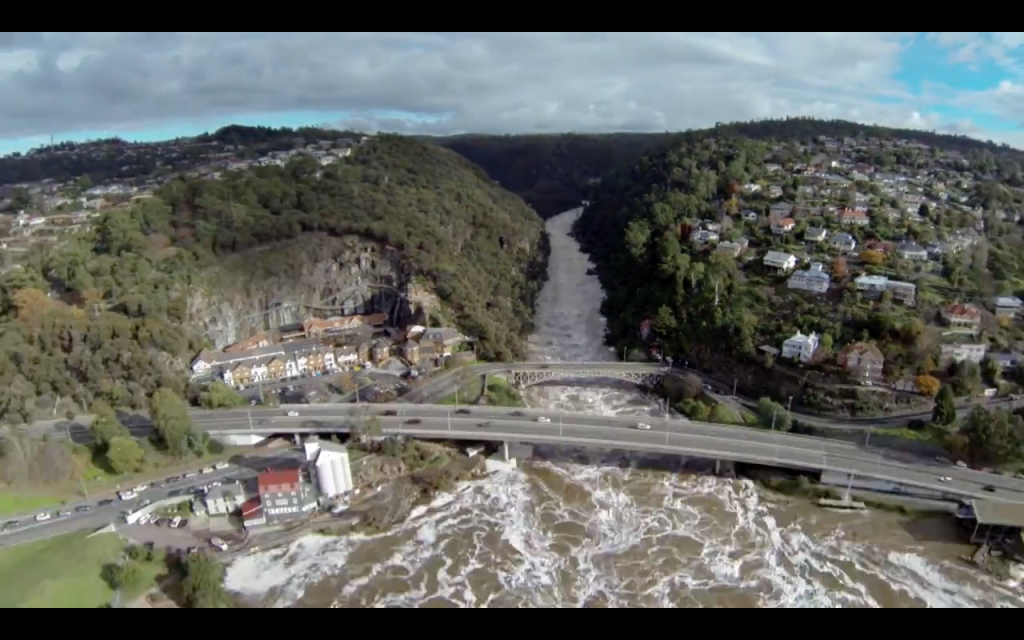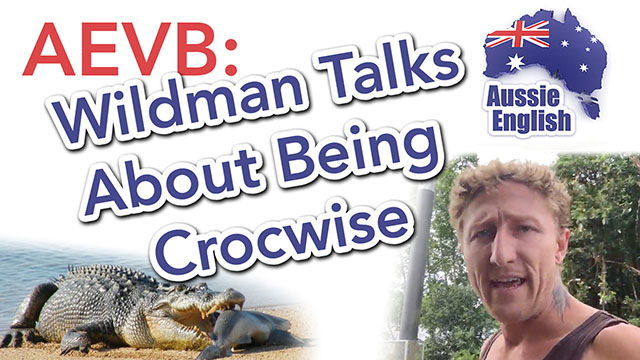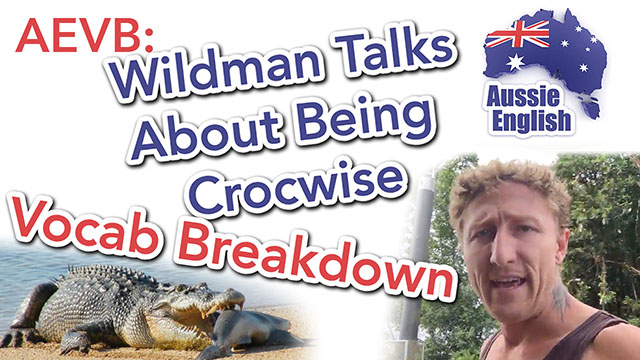AEVB Ep04: Tasmanian Lobsters
Today I break down some of the more complicated words and expressions used in this awesome clip by The Wilderness Society about the Tasmanian lobster.
AEVB Ep04: Tasmanian Lobsters
Video Transcript
This is the largest freshwater invertebrate on the planet. The giant Tasmanian freshwater lobsters is only found in the north-east and the north-west of Tassie and that’s it. It’s just a small coastal strip extending along both areas running into the Bass Straight that they’re found. So even in Tasmania, they’re only found in probably 15% of the state. If you protect lobsters you’re protecting the whole creek and then the riparian zone for 30-40, 50 metres on either side of the creek the whole thing comes into play. I grew up catching lobsters, as a young Tasmanian boy. I went to work in the mainland for fifteen years in aquaculture, I’ve got the background to understand how the ecological system works and just a general feel for the bush. It’s madness for people to think ‘oh no, you want to stop everything’, well no you don’t. You just want to have a decent bit of bush there, mate. You don’t have to be a rabid greenie to say ‘I think I’d like to see this river in good condition in 100 years.’ At the moment we’re on the brink of making a choice, we can either keep clearing all these headwaters and basically having a heap of river systems in Tassie where lobsters are that are full of sediment. Or we can stop and have some river systems that are going to be sediment-free and look like they’re supposed to look before European settlement. Nowadays, we’ve got most of the lowlands stuff done, so they’re heading to the headwaters systems, which is up in the hills a bit. The problem with that is is the sediment gets into the headwaters and runs downstream. It doesn’t matter what you’re doing downstream, if you’re stuffing upstream you’re stuffing the whole river system. And that’s what’s happened. Sediment is by far and away the biggest killer of these animals. I’m not saying that they shouldn’t listed as vulnerable, they should. They’ve been decimated. In a small creek on a hot day with no shade, the water hits 25 the lobsters die. The canopy supplies the food, the shelter and the shade. Everything comes from the bush. What I do nowadays is more just the tagging and researching of populations just to see how they’re traveling. He’d weigh about 1.7 kilo, he’s got scars all over his body from fighting. There is a nice scar there where he has had his antenna taken off. So, he’s been quite an active boy. For me, it’s just walking through the man ferns, to get to these beautiful rivers that are in the middle of nowhere with tannin stained water, clean rocky bottoms, big myrtles, big blackwoods, man ferns all over the place. There’s shade, you’ve got these fantastic animals living in them. They’re a great part of the world, why shouldn’t we look after it? We can’t lock up the world, but it’s got to be balanced. If a headwater goes, that’s it. You cannot put the whole thing back and make a river. And I’d say that three quarters of the river systems in the north of the state have got sediment issues. And the ones that are left are, you know, slowly dwindling, and if we start trashing those headwaters there is no come back from that. It’ll just be another ditch. If that’s what people want, that’s fine. That’s up to them, but if we don’t make the choice now we’re gone. Those systems are stuffed.
Vocabulary
Ok guys, let’s break down the vocab that we just heard in that video about lobsters in Tasmania. So, I’ll go through all the ones that I’ve highlighted in the text that I think will probably be a little difficult to understand. [I’ll] help you um… understand and then listen to the video again.
Invertebrate
So, the first one is “Invertebrate”, and an invertebrate is an animal that doesn’t have a backbone. So, unlike vertebrates, the opposite of an invertebrate, a vertebrate has a backbone. So, humans, fish, cats, birds, lizards, anything that has a skeleton and has a backbone is a vertebrate. Things that aren’t vertebrates that are invertebrates are snails, insects, crustaceans, worms, those things that don’t have backbones. So, that’s what an invertebrate is.
Tassie
The next word is “Tassie”, and Tassie is just the nickname of the state Tasmania. So, you’ll often hear Australians refer to Tasmania as Tassie.
The headwaters
So, “The headwaters”, or the headwater. The headwaters or headwater is the furthest place upstream along a river. So, often into the mountains where the water is originating from. So, the very very start of a river or a stream or a creek. Whatever that water source is is the headwater.
The riparian zone
The next one is “The riparian zone”, and the riparian zone is the area just on either side of a river between the land further beyond the river and the river itself. So, the environment, the ecosystem, all of the plants and animals that are associated with that area right next to the river. So, you’ll often find different kinds of animals, like frogs, those sorts of things are going to be closer to the river, so that area where those are found is the riparian zone.
The mainland
“The mainland.” By “the mainland” he just means to say “the mainland of Australia”.
A general feel for something
So, “A general feel for something” just means to have a general understand or a general competency for something, so, that you’ve got sort of a base knowledge and you know how to do it or use it or understand it.
A rabid greenie
“A rabid greenie.” A rabid greenie. So, there’s two words in here that I should probably explain. Rabid is like the word rabies. So, it sort of means crazed, you know, if a dog has rabies it’s rabid, it’s crazy, it’s, you know, dangerous, it could attack. A rabid greenie is obviously a greenie that is rabid or is very ah… excited, passionate, full on, you know, almost to the point of being scary. And a greenie is just someone who campaigns for the protection of the environment. So, obviously trees are green and that’s where that word “greenie” comes from. They’re worried about the environment. So, we’ve got the green party in Australia. If you vote for them, you support them, you could be considered “a greenie”. So a rabid greenie is a fanatical person who campaigns for the protection of the environment.
To be stuffing/to be stuffed/to stuff
“To be stuffing, to be stuffed, or to stuff something.” This can be used in a few different ways, but in this way he’s talking about to ruin, to destroy or to trash something. So, if you were to stuff a river system up it would mean that you’ve ruined the river system, you’ve destroyed it, you know, you’ve trashed it.
To be travelling
“To be travelling.” It doesn’t mean literally to be travelling as in to move from one location to another location, you know, like if I was driving from Melbourne to Sydney, I’m travelling from Melbourne to Sydney. In this case, it’s said when referring to seeing how someone or something is going or do. So, “How are you travelling” could be “How’re you going? Are you ok?”. So for example, if my dad broke his leg and he was in the hospital and I came to check on him and see how he was I could say, “Dad, how’re you travelling? Are you travelling ok dad? I hope you’re travelling alright.”
To trash
And the last one “To trash.” To trash is kind of like the “to stuff” that we went over just previously. It means to ruin, to destroy or to stuff something up. So, if you trash a river system it’s sort of that idea of taking garbage and putting it in the river system. You’re trashing it. You’re effectively ruining it by adding all that stuff in there, it’s getting trashed, it’s getting ruined. So, if you trash the environment it’s normally by bulldozing it and putting a lot of trash in there, literally trash, and that’s… that’s to trash.
So, listen to the video again guys and see if that’s helped. Hopefully you understand these more difficult words when you listen.
Video Transcript
This is the largest freshwater invertebrate on the planet. The giant Tasmanian freshwater lobsters is only found in the north-east and the north-west of Tassie and that’s it. It’s just a small coastal strip extending along both areas running into the Bass Straight that they’re found. So even in Tasmania, they’re only found in probably 15% of the state. If you protect lobsters you’re protecting the whole creek and then the riparian zone for 30-40, 50 metres on either side of the creek the whole thing comes into play. I grew up catching lobsters, as a young Tasmanian boy. I went to work in the mainland for fifteen years in aquaculture, I’ve got the background to understand how the ecological system works and just a general feel for the bush. It’s madness for people to think ‘oh no, you want to stop everything’, well no you don’t. You just want to have a decent bit of bush there, mate. You don’t have to be a rabid greenie to say ‘I think I’d like to see this river in good condition in 100 years.’ At the moment we’re on the brink of making a choice, we can either keep clearing all these headwaters and basically having a heap of river systems in Tassie where lobsters are that are full of sediment. Or we can stop and have some river systems that are going to be sediment-free and look like they’re supposed to look before European settlement. Nowadays, we’ve got most of the lowlands stuff done, so they’re heading to the headwaters systems, which is up in the hills a bit. The problem with that is is the sediment gets into the headwaters and runs downstream. It doesn’t matter what you’re doing downstream, if you’re stuffing upstream you’re stuffing the whole river system. And that’s what’s happened. Sediment is by far and away the biggest killer of these animals. I’m not saying that they shouldn’t listed as vulnerable, they should. They’ve been decimated. In a small creek on a hot day with no shade, the water hits 25 the lobsters die. The canopy supplies the food, the shelter and the shade. Everything comes from the bush. What I do nowadays is more just the tagging and researching of populations just to see how they’re traveling. He’d weigh about 1.7 kilo, he’s got scars all over his body from fighting. There is a nice scar there where he has had his antenna taken off. So, he’s been quite an active boy. For me, it’s just walking through the man ferns, to get to these beautiful rivers that are in the middle of nowhere with tannin stained water, clean rocky bottoms, big myrtles, big blackwoods, man ferns all over the place. There’s shade, you’ve got these fantastic animals living in them. They’re a great part of the world, why shouldn’t we look after it? We can’t lock up the world, but it’s got to be balanced. If a headwater goes, that’s it. You cannot put the whole thing back and make a river. And I’d say that three quarters of the river systems in the north of the state have got sediment issues. And the ones that are left are, you know, slowly dwindling, and if we start trashing those headwaters there is no come back from that. It’ll just be another ditch. If that’s what people want, that’s fine. That’s up to them, but if we don’t make the choice now we’re gone. Those systems are stuffed.
Here's what you get when you sign up!
- Read while you listen using the Premium Podcast player.
- Understand every word in every episode.
- Download all PDF transcripts and MP3s for 600+ episodes.
- Get access to bonus member-only episodes.












Responses